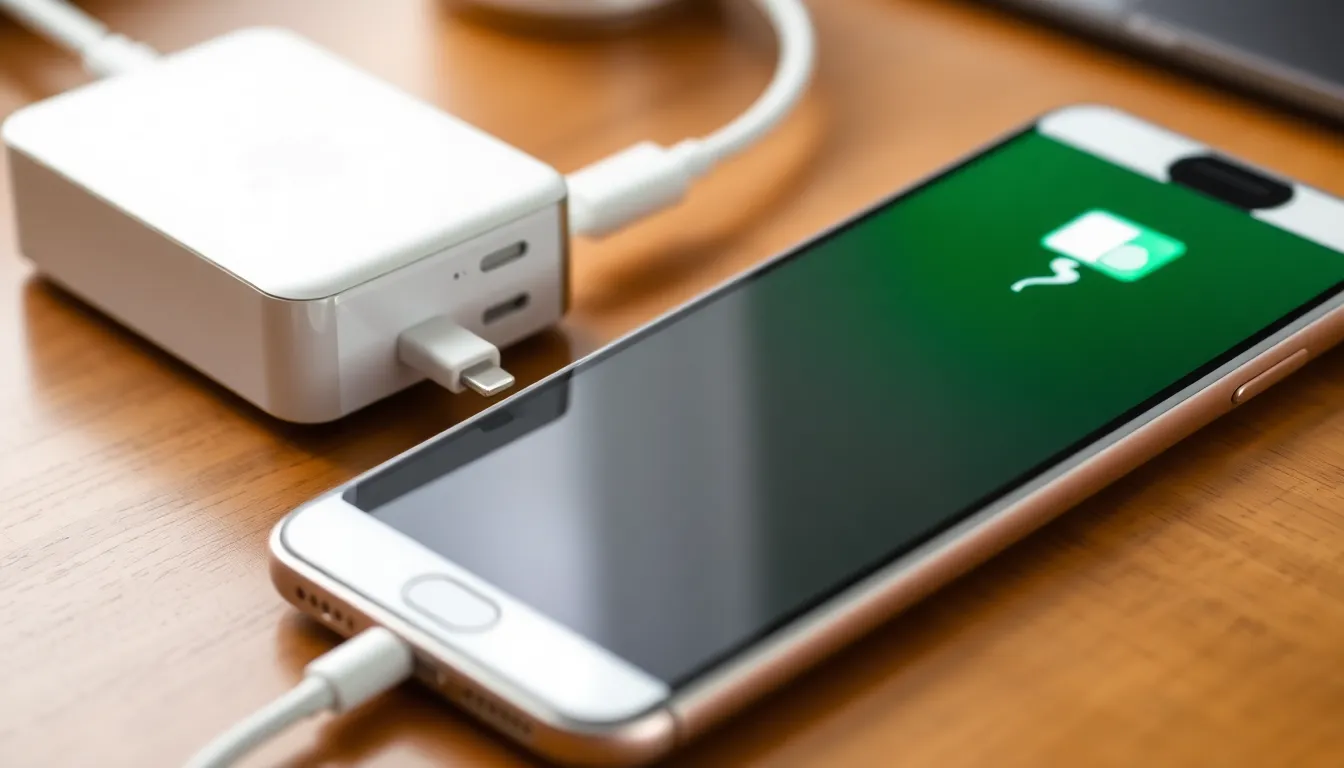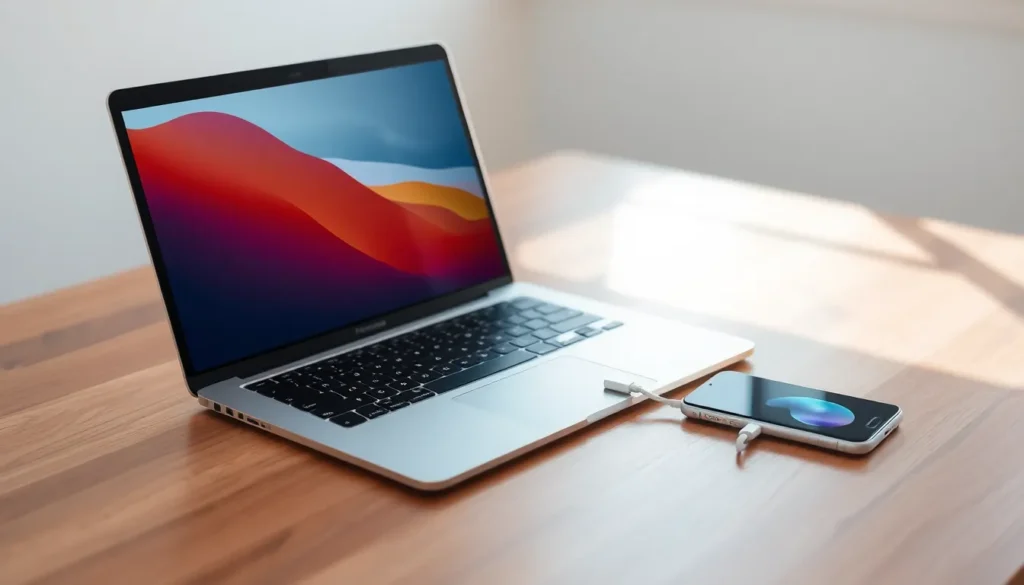In a world where chargers seem to multiply like rabbits, the question arises: can you charge your iPhone with a MacBook charger? Picture this: you’re at a coffee shop, your iPhone’s battery is gasping for life, and your MacBook charger is sitting there like a loyal sidekick. It’s tempting, right?
Table of Contents
ToggleOverview of Charging Technologies
Charging technologies play a crucial role in determining how devices draw power. Understanding these technologies helps users assess the compatibility between chargers and devices.
USB-C vs. Lightning
USB-C connectors provide a universal charging solution for multiple devices. This type of port is found on newer MacBook models and offers faster data transfer and power delivery. Lightning connectors are specific to Apple devices like the iPhone and iPad. Flexibility lies in the fact that adapters exist to bridge these two types, allowing functionality between both connections. An iPhone can connect to a USB-C charger using a Lightning to USB-C cable, effectively enabling it to charge using a MacBook charger.
Power Delivery Standards
Power Delivery standards define how power flows between devices. These standards ensure optimized charging based on the requirements of each device. MacBook chargers generally support higher wattage, reaching up to 96 watts or more, while iPhone chargers usually range from 5 to 20 watts. When using a MacBook charger, the iPhone adapts to the lower power needs, ensuring safe and efficient charging. Adopting the Power Delivery protocol enhances charging speeds, making it beneficial when charging multiple devices.
Can You Charge iPhone With MacBook Charger?

Charging an iPhone with a MacBook charger is indeed possible. Both chargers utilize USB-C technology, allowing for compatibility through the right cables.
Compatibility of Chargers
MacBook chargers work with iPhones due to the USB-C to Lightning cable. The iPhone recognizes the power source and can adapt accordingly. Devices designed by Apple often feature built-in mechanisms to ensure safe charging. Using the correct adapter eliminates concerns about device damage. Checking cable specifications ensures optimal performance. Many USB-C cables on the market meet these requirements, enhancing compatibility.
Charging Speed Differences
Charging speed can vary significantly between the two charger types. MacBook chargers provide higher wattage, typically ranging from 30 to 96 watts. Meanwhile, iPhone chargers deliver from 5 to 20 watts. When connecting an iPhone to a MacBook charger, it will draw only what it requires, minimizing the risk of overheating. Users often notice faster charging times when using a MacBook charger, especially with Power Delivery support. However, the iPhone won’t exceed its maximum charging capacity, ensuring safety while optimizing charging efficiency.
Safety Considerations
Charging an iPhone with a MacBook charger presents certain safety considerations. Understanding these factors ensures users charge their devices effectively without compromising their safety.
Overheating Risks
Overheating can be a concern when using a MacBook charger to power an iPhone. This risk arises from the higher wattage potential of the charger. However, the iPhone contains built-in safeguards that regulate power intake, thereby preventing excessive heat buildup. Drawn power depends solely on the iPhone’s needs, so overheating is generally minimized. Users should continuously monitor their device’s temperature during charging to ensure it remains within safe limits.
Battery Health Impact
Battery health can be influenced by the charging method used. Utilizing a MacBook charger with an iPhone may offer faster charging, yet consistent high-speed charging can impact battery lifespan over time. Apple recommends maintaining battery levels between 20% and 80% for optimal health. Adjustments made by the iPhone in response to charging currents can safeguard battery health while using a MacBook charger. Ensuring users utilize the charger appropriately contributes positively to long-term battery performance.
User Experiences and Reviews
Users often share diverse experiences when charging an iPhone with a MacBook charger. Feedback typically highlights both advantages and disadvantages.
Positive Feedback
Many users appreciate the versatility of using a MacBook charger for their iPhones. One user noted that charging was noticeably faster when using a MacBook charger compared to a standard iPhone charger. Others mentioned the convenience of having only one charger for multiple devices, especially when traveling. The compatibility of USB-C provides flexibility for those with newer MacBook models. A review shared online stated that the iPhone displayed a charging indicator that confirmed safe power delivery, easing worries about potential damage. Efficiency is a common theme, with users feeling satisfied that their iPhones adjusted power intake properly and prevented overheating.
Negative Feedback
Negative experiences frequently arise from concerns about battery health. Some users report anxiety over the potential long-term effects of using a higher wattage charger. A few individuals expressed worries about device overheating, even though the iPhone’s built-in safety features are designed to manage power consumption. One user experienced slower charging speeds in colder environments, which could lead to frustration during urgent charging needs. Negative feedback includes uncertainty regarding charger quality, particularly with third-party adapters. Users urge caution when opting for non-Apple branded cables, fearing they may not provide the same safety and performance.
Charging an iPhone with a MacBook charger is not only possible but also practical when the right cables are used. The compatibility of USB-C technology allows for efficient power transfer while ensuring the iPhone adapts to its power needs. Users can enjoy the benefits of faster charging times without compromising safety, thanks to the built-in safeguards of the iPhone.
While the convenience of using one charger for multiple devices is appealing, it’s essential to monitor device temperature and consider the long-term effects on battery health. By following recommended charging practices, users can maximize their devices’ performance and longevity. Overall, leveraging a MacBook charger for an iPhone can enhance the charging experience, provided users remain mindful of the potential risks.








